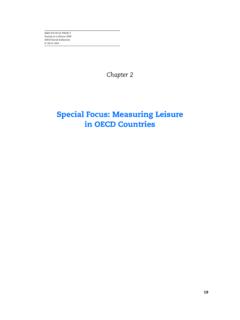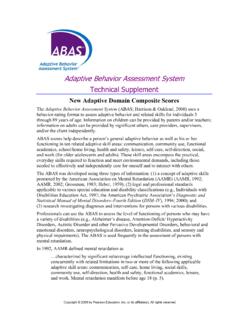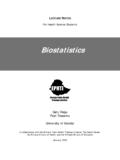Transcription of gender and malaria - WHO | World Health Organization
1 gender , Health GenderandHealthDespite prevention and control efforts, malaria remains a leading cause of morbidityand mortality worldwide. According to data for 2005, an estimated 1 million deathswere related to malaria . Most of these deaths occur in children in high-transmission areasand malaria accounts for approximately one in five of all childhood deaths in , the true burden of malaria is difficult to estimate as many people are treated athome and no proper postmortem diagnosis is made in the case of death. As a result, manymalaria cases go unreported. (1) A gender approach contributes to both understanding andcombating malaria . gender norms and values that influ-ence the division of labour, leisure patterns, and sleepingarrangements may lead to different patterns of exposure tomosquitoes for men and women. There are also genderdimensions in the accessing of treatment and care formalaria, and in the use of preventative measures such asmosquito nets.
2 A thorough understanding of the gender -related dynamics of treatment-seeking behaviour, as well asof decision-making, resource allocation and financialauthority within households is key to ensuring effectivemalaria control programmes. Therefore, gender and malar-ia issues are increasingly being incorporated into malariacontrol strategies in order to improve their coverage andeffectiveness in different do we know?There are four main types of parasite that cause humanmalaria - Plasmodium vivax,P. malariae,P. ovaleandP. falciparummalaria is the most deadly,and is most common in sub-Saharan Africa, accountingin large part for the extremely high malaria -relatedmortality in this region. (2)Those at highest risk biologically are infants and youngchildren (from six months to five years), pregnant women, non-immune people (such as travellers, labour-ers and populations moving from low-transmission to high-transmission areas) and people living with evidence suggests that given equal exposure,adult men and women are equally vulnerable to malaria infection, except for pregnant women who are at greaterrisk of severe malaria in most endemic areas.
3 (3)Data on malaria is often not is a particular problem for pregnant womenThe rate of malaria infection is higher in pregnant women because of their decreased immunity. Studieshave shown that infection rates are highest in first andsecond parity women with lower rates in later pregnan-cies. (4, 5, 6)Pregnant women with malaria have an increased risk ofabortion, stillbirth, premature delivery and low-birth-weight infants. (3, 5, 6)P. falciparumis generally accepted as a leading cause ofanaemia in pregnant women. (7) It is estimated that anaemia causes as many as 10 000 maternal deaths eachyear. (4) However, despite the dangerous impact of malaria on pregnant women and their infants, it is esti-mated that less than 5% of pregnant women have access to effective interventions. (5)Although P. v i v a xis a more common cause of malariathan P. falciparumin many parts of the tropics outside Africa, much less is know about its harmful effects on pregnancy.
4 Available research indicates that althoughthe effects of P. vivaxinfection are less severe compared to P. falciparum,P. v i v a xmalaria during pregnancy is also associated with maternal anaemia and low birthweight. (8)Women with dual HIV and malaria infection are at particular risk of severe anaemia and adverse birth out-comes. One study in Kenya found that HIV-seroposi-tive women with malaria were twice as likely to have anaemia than HIV-seronegative women with orwithout malaria . (9)June 2007andMalariaAdolescent girls are particularly vulnerable to many sub-Saharan African settings, adolescents are often parasitaemic and anaemic when they first becomepregnant. According to data from Malawi, bothnon-pregnant and pregnant adolescent girls hadsignificantly higher parasite rates than women over19 years of age. (10)As adolescents often face difficulties in accessing healthservices, pregnant adolescent girls might not seektimely care for malaria .
5 Participants in a study inUganda, for example,perceived pregnant adolescents asa group least likely to use antenatal care. (11) Although the study indicated that pregnant adolescents recog-nized the importance of seeking preventive care for malaria , there were several constraints that limitedaccess to services. These were mainly the stigmaassociated with adolescent pregnancy and the negativeattitude of Health workers. Similar findings were alsoreported in a study in Nigeria. (12)Patterns of exposure often coincide with gender normsand behaviourIn some societies, men have a greater occupational risk of contracting malaria than women if they work in mines, fields or forests at peak biting times, or migrateto areas of high endemicity for work. (3) Women who get up before dawn to perform household chores mayalso be exposed to mosquitoes and consequently tomalaria infection.
6 (13)In other societies, the activities of men and womenduring peak biting times may result in equal risks of infection. For example, a study in Myanmar on activities that enhance human-vector contact revealed thatgender-specific patterns of both leisure and workactivities during peak biting periods by men and womenplaced them at equal risk of contracting malaria throughexposure to mosquitoes. (14)The division of labour as a result of gender roles mayplay a significant part in determining exposure tomosquitoes. However very few studies have beenconducted to specifically look at , in addition to leisure activities, sleepingarrangements may also affect malaria transmission. Insome societies, men tend to sleep outdoors and this mayincrease their risk of exposure to mosquitoes. (15)Understanding how gendered patterns of behaviourinfluence exposure to mosquitoes can therefore assist indeveloping more-effective recommendations forpreventing malaria to Health care services for malaria can be affectedby gender issues, including gender inequalityWomen often have to ask for their husband's permis-sion to access treatment for themselves and/or theirchildren.
7 (16) A study on gender roles and responses tomalaria in Ghana found that women who lacked eithershort-term or long-term economic support from malerelatives, or who disagreed with husbands or familyelders about seeking appropriate treatment, faceddifficulties in accessing Health care for children with malaria . (17) They also faced the heavy burden of the cost of seeking treatment despite often limited access from some countries indicates that restrictedmobility of women may also impede their attendance atprimary Health care clinics for malaria testing. (18, 19)However, in some settings males utilize Health careservices less than females. For example, a study in PapuaNew Guinea found that adolescent (10-19 year-old) and adult (20-40 year-old) women were more likelythan similarly aged men to walk long distances to obtain malaria treatment at a clinic. (19) The study estimatedthat 37% of infected adolescent males did not attend forcare because of the distance to the clinic.
8 Only ofinfected adolescent females were deterred by distance. Itwas suggested that men may assign a low priority totheir Health , making them reluctant to spend much time walking to a Health centre even when malaria issuspected. On the other hand, the same men indicatedthat they might readily attend a clinic if it was varied findings on access to Health services may be explained by varying gender roles and relations acrosssocieties, and the gender dynamics of decision-makingand access to financial resources. Social customs too canaffect the treatment-seeking behaviour of women andmen and their access to Health services. In Tigray,Ethiopia, focus groups revealed that women arereluctant to see male Health workers for cultural reasons,and this may contribute to underreporting of malariacases among women in the study area. (18)Another study in Ethiopia found that women were using Community Health Worker services for malarialess frequently than men because their workload leftthem little time to attend to their own and theirchildren's Health needs.
9 (20) In addition, men dominat-ed in decision-making, and women were not in thehabit of expressing their needs and might even beperceived as sexually disloyal if they visited a malehealth is possible that in settings where there are differentethnic groups, and consequently different languages,that communication with Health care workers may be more difficult for women than for men. For example, a study in rural Burkina Faso found that communicationbetween Health workers and patients was easier withmen since they generally spoke more languages. (21)The study found that 24% of adult women were unableto communicate with the Health care worker in the samelanguage compared with only 10% of of education may also affect malaria treatment-seeking and prevention behaviours. A study in south-eastern Nigeria found that higher levels of education were associated with improved knowledge and practices in relation to appropriate prevention and treatmentstrategies.
10 (22) Although the study did not include a gender analysis, as women tend to have lowereducational and literacy levels than men, this may affecttheir ability to recognize the signs and symptoms ofmalaria and their knowledge of available both men and women in areas of endemic tropical diseases suffer from discrimination due to classinequality and poverty, women are particularlydisadvantaged due to factors linked with genderinequality. A study in Cameroon found that the burdenof illness due to malaria rested disproportionately oneconomically disadvantaged women and on women with low social status. (23) Excess morbidity was found among women who were not employed, women living in poor neighbourhoods, and those living in householdswithout modern women in most parts of the World have the primaryresponsibility of caring for others in the household, it isthey who provide the majority of treatment to sickfamily members.
















